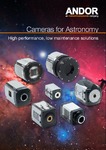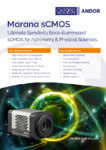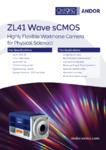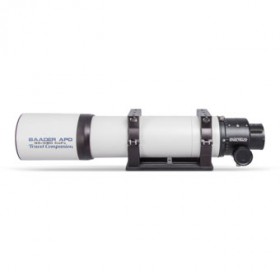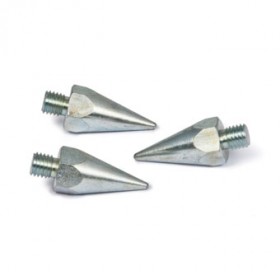Product Questions and Answers
Do you have a question about this product? Then we would like to ask you to first look through the existing questions and answers, most likely your question has already been answered and you will get the desired information much faster this way. Your question is not listed? Then please click on the button "Ask a question".
- Description
-
Details
Andor Technology’s sCMOS camera series (Balor, Marana, ZL41)
Andor’s scientific CMOS (sCMOS) cameras represent a breakthrough technology based on next-generation CMOS Image Sensor (CIS) design and fabrication techniques. Because of their special characteristics - extremely low read noise and fast frame rates - they are ideal camera solutions for various applications in physics and astronomy.
The Balor, Marana and ZL41 sCMOS cameras are specifically designed to provide the highest level of sensitivity (i.e., front and back-illuminated sensors). In contrast to previous CMOS or CCD technologies, these cameras offer maximum sensitivity, resolution, speed, and field of view at the same time. In addition, the sensors of the Balor and Marana can be cooled down to -30°C, -45°C or -40°C, thanks to the vacuum sensor enclosure technology.
Furthermore, Andor’s Balor, ZL41 cameras allow to select rolling as well as global shutter modes, whereas global shutter is similar to a ‘snapshot mode’.
Balor - Andor’s game-changing, very large area sCMOS camera for Astronomy
Balor features an enhanced FoV 16.9 Megapixel, 70mm diagonal front-illuminated sensor, coupled with high speed and low read noise capability. The Balor sCMOS has a read out rate of 18.5ms, offering 54 fps at full frame and read noise of <3 electrons.
Marana
The Marana utilizes back-illuminated sCMOS sensors with 4,2 Megapixels and a quantum efficiency of up to 95%. This camera model is available with sensors of 11 µm and 6,5 µm pixel size. One of the sensor options also features UV opimization with high sensitivities in the wavelength range between 250-400 nm.
ZL41
The ZL41 sCMOS cameras, with read noise of only 0,9 electrons, can provide 100 fps (via CameraLink connectivity) at full frame (higher frame rates possible by using ROIs). The ZL41 is available with two front-illuminated sensor formats: 5,5 Megapixel and 4,2 Megapixel with pixel sizes of 6,5 µm. The ZL41 5.5 offers rolling and true global shutter functionality, whereas the ZL41 4.2+ has rolling shutter only, but provides a higher quantum efficiency of 82% peak QE.
Typical Applications:
- Space Debris Tracking, SSA
- Solar Astronomy,
- Photometry,
- X-Ray Astronomy,
- Exoplanet Studies,
- Synchroton Facilities,
- High-Speed Spectroscopy (e.g., Marana and ZL41for Multi-Track and Hyperspectral Imaging)
Further information about Andor’s sCMOS camera solutionss can be found on Andor Technology's website.
Please note: We offer ANDOR cameras exclusively for astronomical applications and satellite tracking. This is in response to requests from companies, institutes and amateur astronomers to integrate these high-quality special cameras into telescope systems and observing stations.
In case you have further questions, please contact us via kontakt (at) baader-planetarium.de
Please note that additional information and spec sheets are available in the “downloads” section.
Additional Information
| General | |
|---|---|
| SKU (#) | Andor_sCMOS |
| Application | Cameras for Spectroscopy, Scientific Cameras |
| Sensor Information | |
| Sensor type | BSI CMOS – Back-side illuminated, FSI CMOS – Front-side illuminated |
| Sensor Size | 16.6 x 14.0 mm bzw 13.3 x 13.3 mm (Zyla) | 16.6 x 14.0 mm (Neo) | 22.5 mm x 22.5 mm bzw. 13.3 mm x 13.3 mm (Marana) | 49.5 x 49.2 mm (Balor) |
| Imaging Features | |
| Monochrom or Color? | Monochrome |
| Maximum Frame Rate | up to 100 fps (full frame) |
| Dynamic Range | up to 53.000 : 1 |
| Read Noise (e- RMS) | down to 0.9 electrons |
| A/D Conversion | 12bit and/or 16bit (depending on model) |
| Peak QE | up to 95% |
| Shutter | No mechanical shutter (only electronic) |
| Additional Features | |
| Cooling | down to -45°C |
 Product Information
Product Information
 Flyers
Flyers

